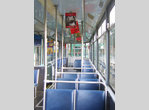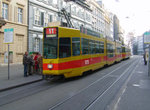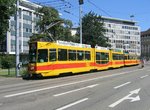Basel, Switzerland
![]()
Basel tram on route 11 at Mittlere Brucke. Photo by Jos Straathof, 2006.
Overview
Basel, Switzerland's third largest city, has a varied and particularly interesting tram system. Not only are trams operated by, and painted in the different liveries of, two separate organisations, there is a considerable number of different car types in operation and some unusual track layouts present.
The majority of services are operated by Basler Verkehrs-Betriebe (BVB), with a fleet of attractivley-liveried green trams. BVB also operates the city buses, and a solitary trolleybus line. Complementing the BVB services are those provided by Basel-land Transport (BLT), which is respsonsible for public transport in Canton Basel - as opposed to BVB, which only covers the city. BLT's orange and yellow trams operate two long, interurban services. Route 10 runs from Rodersdorf in Canton Basel, through the city centre, and back out into Canton Basel to terminate at Dornach; route 11 operates from Aesch, again in Canton Basel, through the city centre and terminates metres away from the French border in the north of the city, at St Louis Grenze. Route 10 is particularly unusual in that one stop is actually situated in France, thus turning this route into an international tram line. This stop in France, Leyman, is the penultimate stop on the BLT 10 line. It is particulary interesting as it is the most unchanged stop since the line to Rodersdorf was converted from a light railway to the current tramway. As this stop is actually in France, and since Swizerland is not a signee of the Schengen border treaty, passports are required to alight here!
BLT also operates two peak-hour only routes. Line E11 complements the southern section of route 11, following a circular route in the city centre, whilst line 17 runs from Ettingen (on the line to Rodersdorf), through the city centre to Wiesenplatz. The northern portion parallels BVB's busy Combino-operated line 8, and is the only operation which takes BLT cars north of the Rhine river. To terminate at Weisenplatz it uses the loop which accesses the adjacent BVB tram depot.
Mainstay of the BLT fleet is a somewhat unusual looking Schindler articulated type, built during the late 1970s and early 1980s. Some operate in as-built two section form, whilst many have been rebuilt with a low-floor centre section to provide disabled access. Other cars operated are a number of older Schindler and similar-looking Duewag articulated cars, along with several trailers - of which a handful date from 1948! The trailers are restricted to use on peak-hour only route 17, whereas trams on routes 10 and 11 are formed of two articulated units coupled together. The leading car is usually a later Schindler articulated unit with low-floor section; another Schindler unit of either type, or a Duewag unit, is the towed car. Although both the lines are busy during rush hours, the more distant sections see low passenger numbers off-peak.
BVB's tram lines operate solely within the city of Basel, with one exception - line 14's five easternmost stops, including the Pratteln terminal, are outside the city boundary, in Canton Basel. BVB's operation of what should strictly be a BLT line is in compensation for the suburban operator's services being extended into and across the city. BVB's fleet, with its attractivley-liveried trams turned out in excellent condition, is more varied than BLT's and includes some modern, fully low-floor cars.
A number of classic Duewag articulated cars can be seen in use, although appearances in passenger-carrying service seem a little sporadic. When they do perform as such, they seem to operate as two units coupled together - single units are popular as training cars, however. Some have apparently already been sold to the Sarajevo tramway in Bosnia, and given the good condition the remaining units are in it would seem that they too will see further use elsewhere after retirement from Basel.
A variety of elderly Schindler-built Swiss Standard cars remain in use. Some are motorised driving cars, with the remainder being trailers - although it's not apparent as to whether the trailers are motorised. They lack pantographs, but it's questionable as to whether one driving motor car could tow two trailers up some of Basel's severe gradients, as would be the case if they were non-motorised. Some of the trailers have been ingeniously rebuilt, with the centre section 'scooped out' to provide a low-floor area between the trucks.
Mainstay of BVB's tram fleet is the more modern Schindler type, in both articulated and single-car form. The articulated cars feature a low-floor centre piece and are of identical design to those operated by BLT. They frequently tow single-car trailers. A number of this design also operate as single-car units, and tow either one or two trailers. It is common to mix Swiss Standard cars with this newer design, although when this happens the driving car in a non-articulated set is always a newer type; any Swiss Standard cars in the formation are used as trailers.
The most modern car type in the BVB fleet is the troubled Siemens Combino, a multi-section articulated unit which is principally to be found on routes 6 and 8. 28 of these vehicles are operated, and at 43 metres long they were the longest Combinos produced until a batch began construction for Budapest - which dwarf Basel's at a mammoth 54 metres! As with many other batches of Combinos produced for European cities, Basel's suffered from insufficient rigidity in the bodyshell owing to a hiccup in the type's technical specifications. Thus - at Siemens' edict - all will return to the factory for major rectification work to be carried out. A period of tram shortages as a result of this problem led to some of suburban operator BLT's orange and yellow units being lent to BVB to provide cover.
Again as a result of the ongoing Combino crisis, several three-section articulated cars from the early 1970s have been acquired from sister Swiss city Bern. None would seem to have been painted into BVB's livery, perhaps indicating that they will not be long-term additions to the fleet. Usually towing a Swiss Standard trailer, they are relativley spartan internally when compared to the well-appointed indigenous fleet.
Recently ordered was a batch of 60 articulated 'Tango' trams from Swiss builder Stadler. Entry into service of the batch - to be split between BVB and BLT - is apparently to be gradual, between 2008 and 2014 should trials with two initial prototypes prove successful.
Whilst several of the interesting portions of operation are to be found on the BLT lines, there are several notable features of the BVB services too. Best of the lot, though, must be the section between Ettingen and Rodersdorf on BLT route 10, which consists of much single-track operation through rolling fields. This piece of the network definitely has a 'country' feel to it! Also notable is the section of BVB route 16 between Jakobsberg and Bruderholtz, which includes an incredibly sharp curve and a severe gradient. As with both these examples, much trackage outside the city centre - particularly on BLT-operated lines - is in reservation, although a considerable amount of street running is still practiced. This is particularly evident in the city centre - although sharing road space with other vehicles does not pose such an operational problem as it does elsewhere. This is due to Basel's strict policy regarding access to the city centre for motor vehicles, and thus there is little traffic here other than trams, buses, cyclists and pedestrians.
To conclude, Basel's tram system is a fascinatingly varied one, considerably more so than the standardised networks more common in western Europe. With several extensions - including one into Germany - on the drawing board, and a number of new cars due over the next few years, its future looks bright. Away from trams, the city has plenty to offer visitors, and a trip here could easily fill three or four days.
Photo Gallery
| Five Random Images | ||||
 Image 56003 (77k, 600x450) Photo by: Tim Deakin Location: Mittlere Brucke |  Image 56018 (66k, 600x450) Photo by: Tim Deakin Location: Hauptbahnhof |  Image 57977 (47k, 450x600) Photo by: Ben Tite Location: Bahnhofstrasse (Pratteln) |  Image 57985 (44k, 600x450) Photo by: Ben Tite Location: Bankverein |  Image 90858 (178k, 1024x768) Photo by: Jos Straathof Location: Aeschengraben |
Page Credits
By Tim Deakin.